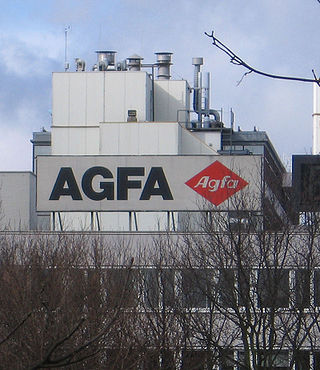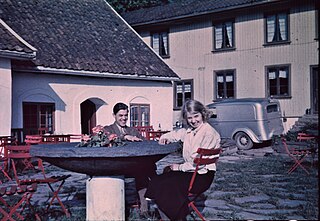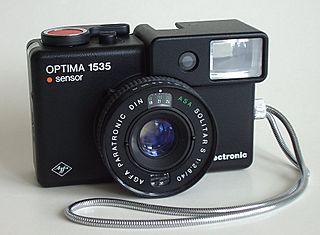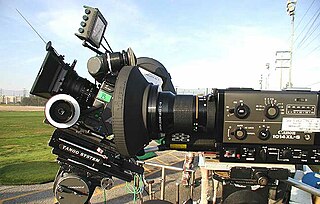
Super 8 mm film is a motion-picture film format released in 1965 by Eastman Kodak as an improvement over the older "Double" or "Regular" 8 mm home movie format.
The following list comprises significant milestones in the development of photography technology.

9.5 mm film is an amateur film format introduced by Pathé in 1922 as part of the Pathé Baby amateur film system. It was conceived initially as an inexpensive format to provide copies of commercially made films to home users, although a simple camera was released shortly afterwards.

Agfa-Gevaert N.V. (Agfa) is a Belgian-German multinational corporation that develops, manufactures, and distributes analogue and digital imaging products, software, and systems.

Film speed is the measure of a photographic film's sensitivity to light, determined by sensitometry and measured on various numerical scales, the most recent being the ISO system introduced in the mid-1970s. A closely related ISO system is used to describe the relationship between exposure and output image lightness in digital cameras. Prior to ISO gaining traction the best known systems were ASA in the U.S. and DIN in Europe.

135 film, more popularly referred to as 35 mm film or 35 mm, is a format of photographic film used for still photography. It is a film with a film gauge of 35 mm (1.4 in) loaded into a standardized type of magazine – also referred to as a cassette or cartridge – for use in 135 film cameras. The engineering standard for this film is controlled by ISO 1007 titled '135-size film and magazine'.

ORWO is a registered trademark of the company ORWO Net GmbH, based in Wolfen and is also traditionally known for black and white film products, made in Germany and sold under the flag of the ORWO brand.

An instant camera is a camera which uses self-developing film to create a chemically developed print shortly after taking the picture. Polaroid Corporation pioneered consumer-friendly instant cameras and film, and were followed by various other manufacturers.

In photography, reversal film or slide film is a type of photographic film that produces a positive image on a transparent base. Instead of negatives and prints, reversal film is processed to produce transparencies or diapositives. Reversal film is produced in various sizes, from 35 mm to roll film to 8×10 inch sheet film.

Agfacolor was the name of a series of color film products made by Agfa of Germany. The first Agfacolor, introduced in 1932, was a film-based version of their Agfa-Farbenplatte, a "screen plate" product similar to the French Autochrome. In late 1936, Agfa introduced Agfacolor Neu, a pioneering color film of the general type still in use today. The new Agfacolor was originally a reversal film used for making "slides", home movies and short documentaries. By 1939, it had also been adapted into a negative film and a print film for use by the German motion picture industry. After World War II, the Agfacolor brand was applied to several varieties of color negative film for still photography, in which the negatives were used to make color prints on paper. The reversal film was then marketed as Agfachrome. These films use Color Developing Agent 1 in their color developer.

Ansco was the brand name of a photographic company based in Binghamton, New York, which produced photographic films, papers and cameras from the mid-19th century until the 1980s.

Digital photography uses cameras containing arrays of electronic photodetectors interfaced to an analog-to-digital converter (ADC) to produce images focused by a lens, as opposed to an exposure on photographic film. The digitized image is stored as a computer file ready for further digital processing, viewing, electronic publishing, or digital printing. It is a form of digital imaging based on gathering visible light.

The Agfa Optima 1535 Sensor is a 35 mm rangefinder camera manufactured by the German company Agfa in 1977.

A Super 8mm camera is a motion picture camera specifically manufactured to use the Super 8mm motion picture format. Super 8mm film cameras were first manufactured in 1965 by Kodak for their newly introduced amateur film format, which replaced the Standard 8 mm film format. Manufacture continued until the rise in popularity of video cameras in the mid-1970s. In 2014 the first new Super 8mm camera in 30 years was introduced by the Danish company Logmar Camera Solutions. Most other cameras readily available are from the 1960s through the 1980s.
A chromogenic print, also known as a C-print or C-type print, a silver halide print, or a dye coupler print, is a photographic print made from a color negative, transparency or digital image, and developed using a chromogenic process. They are composed of three layers of gelatin, each containing an emulsion of silver halide, which is used as a light-sensitive material, and a different dye coupler of subtractive color which together, when developed, form a full-color image.

Pigeon photography is an aerial photography technique invented in 1907 by the German apothecary Julius Neubronner, who also used pigeons to deliver medications. A homing pigeon was fitted with an aluminium breast harness to which a lightweight time-delayed miniature camera could be attached. Neubronner's German patent application was initially rejected, but was granted in December 1908 after he produced authenticated photographs taken by his pigeons. He publicized the technique at the 1909 Dresden International Photographic Exhibition, and sold some images as postcards at the Frankfurt International Aviation Exhibition and at the 1910 and 1911 Paris Air Shows.














